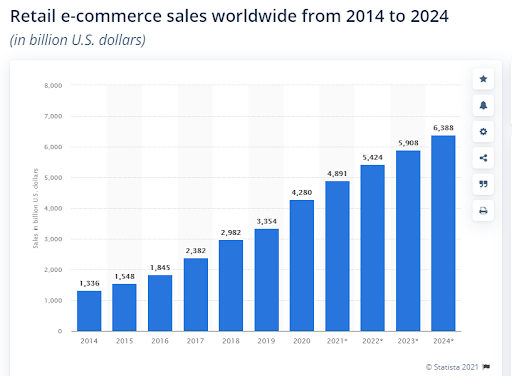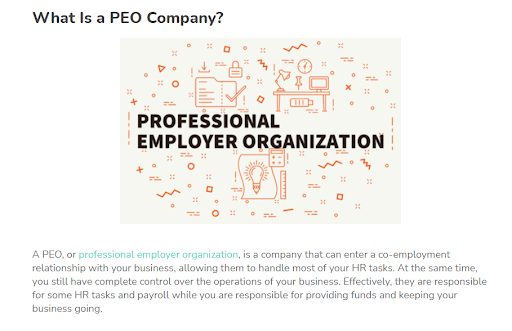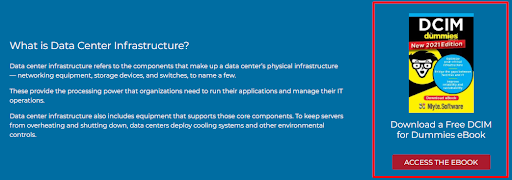There’s some exciting stuff going on in the eCommerce world.
ECommerce businesses are thriving, sales are continuing to rise, and the world has been happily sharing new marketing trends that work.
With eCommerce sales projected to increase by 1.5 billion dollars in 2024, there’s never been a better time to be part of the eCommerce industry.

If you’re thinking of joining the industry — or if you already have an eCommerce store — we have a treat in store for you.
Today, we’ll pull back the curtain and share seven eCommerce content marketing trends you can use to boost sales in 2022.
Let’s get into it.
1. Review guides
Review guides are powerful resources that can sway even the most skeptical audience into becoming loyal customers.
Think of a review guide as a toolbox. It gives your target audience the tools they need to make an informed decision about buying and using your product.
Here are some creative ways you can craft review guides for your customers:
- Write an in-depth blog post covering every aspect of your product.
- Write a social media post sharing the pros and cons of using your product.
- Shoot a product demonstration video and post it on your website and landing pages.
- Shoot short product demonstration reels on Instagram, TikTok, and Facebook.
- Email your customers a relatable story about your product. Include a product review at the end of the story.
- Hire an influencer to test drive your product and review it on their blog, vlog, or social media channels.
- Hire an affiliate marketer to review your product and share their results on their blog. (See the ConvertBox review below for inspiration.)
Another pro tip is finding out where your customers get their trusted recommendations from. Then, ask those websites to review your products.

2. Agency partnerships
Content marketing is a beast. It’s a job in and of itself. Unless you have a killer content team in-house, it’s going to be tough to do content marketing justice.
That’s why hiring a content marketing agency is a trend eCommerce businesses are taking seriously in 2022.
Think of a content marketing agency as a content production company. They piece together keyword research, professional writers, and professional copy editors to produce highly searchable and valuable content.
And the best part? They’re masters at scaling content quickly. So whether you’re just looking to post one optimized blog post a week or you’re looking to create an entire library of blog posts, an agency can help you get there.
Here are some additional benefits you can gain when you work with a content agency:
- Skip the costly trial-and-error phase most content marketers face
- Understand the exact return on investment (ROI) you’re getting with content marketing
- Position yourself as an industry expert
- Research into what competitors are doing
- Boost your site’s domain authority
- See your content ranked at the top of search engines
- Have access to a wider pool of content marketing experts

3. Cultural and multilingual content
More eCommerce brands are expanding their global reach — and why wouldn’t they? There’s no limit to how many people you can market to when you have an online business.
That’s why infusing cultural and multilingual content into your marketing strategy is a must if you have a global customer base.
Brands capitalize on this trend by:
- Providing content in multiple languages
- Sharing fun cultural norms, customs, and traditions on their blogs and social channels
- Interviewing international thought leaders and business leaders in videos, podcasts, and social channels
- Sharing recipes, design trends, tech trends, and fashion trends from around the world
- Diversifying their content to represent minority groups and marginalized communities
- Supporting diversity and inclusion movements

Interested in using this trend but unsure of where to start? Find out where most of your customers are from and tailor your content strategy with them in mind.
For instance, if you have a food and beverage store, consider selling products from the specific regions your customers are from. Then, feature your new international products in blog posts, promotional emails, and on social media platforms.
4. It takes a village
It’s tempting to bite off more than you can chew in an attempt to save money, but when it comes to content marketing, you have to spend money to make money.
In other words, it takes a village to bring your eCommerce content marketing strategies to life.
As your content marketing needs grow, you’ll need to hire a team to help you manage the ins and outs. We already discussed hiring a content marketing agency, but there are other key players when it comes to content marketing.
Here are some roles you may need to fill to bring your content marketing strategies to fruition:
- Marketing director: To research marketing trends, oversee the marketing department, and manage major campaigns.
- Public relations rep: To boost your brand’s reputation, keep an eye on your brand’s image, and put out public relations fires when needed.
- Diversity and inclusion rep: To oversee your diversity and inclusion efforts, ensure all content is inclusive, and share inclusive strategies.
- Product manager: To create demand for your products through careful research and effective positioning.
If hiring for these roles sounds overwhelming, we recommend hiring a PEO company to do all of the heavy lifting for you. Here’s what a PEO company does:

5. Educational content
Educational content has always been something of a priority for eCommerce brands. But these days, educational content has become vastly important.
Not only does educational content boost brand recognition, but it’s also a powerful tool for building trust and connection. In other words, educational content is key to building long-term relationships with your customers.
When creating educational content, keep these quick tips in mind:
- Focus on sharing high-quality content based on visitor intent.
- Use educational content to answer frequently asked questions (FAQs).
- Before publishing something, ask yourself if the content is engaging, helpful, inspiring, and/or valuable.
- Start with the end in mind. Always consider your audience’s readability level, education level, and demographic before creating content. If you sell business-to-business, consider your audience’s job roles and level of expertise before content creation.
Still not sure what kind of educational content your brand should create? Here are five ideas to start with:
Ebooks
Ebooks are helpful guides readers turn to whenever they need extra help learning about a topic. They’re especially helpful if you sell a product or service that’s difficult to understand or comes with a learning curve.
The following ebook on data center infrastructure written by Nlyte Software is a perfect example:

Datacenter infrastructure isn’t an everyday topic people know about. By offering an ebook on the topic, Nlyte Software educates its audience, builds trustworthiness, and grows its lead list in the process.
Webinars
Webinars are another great way to break down dense information, answer FAQs, and collect contact information.
You can use webinars:
- For product tours and demonstrations
- To discuss upcoming product and/or brand updates
- To host basic trainings followed by product launch announcements
- To share case studies and testimonials
- To interview industry experts
Podcasts
Podcast shows are an effective way to humanize your brand and show off your brand’s personality. Podcasts can also help you form deep bonds and connections with your audience. Don’t be surprised if your audience considers you a dear friend after listening to a few episodes.
If you decide to host a podcast show, our best advice is to stay consistent and focus on user intent. Choose a specific day and time each week to host your podcast and stick to it. Work with your marketing director to come up with a list of topics based on your target market’s search habits.
Optimized and value-focused blog posts
There’s a rumor going around that blogging is dead, but nothing could be further from the truth. In fact, the number of bloggers in the U.S. steadily increases each year.
Yes, videos, infographics, photos, and other forms of content are popular, too, but blog posts do something no other form of content can. They give audiences a clear introduction, body, and conclusion on any given topic in an easy-to-digest format.

That’s why a collection of blog posts is sometimes called a knowledge base. Think of it as an encyclopedia or a master library full of text on niche topics.
The key to writing blog posts that turn heads is focusing on writing optimized and value-focused articles. This is where that content production agency really comes in handy. An agency can do all of the heavy keyword research and SEO (Search Engine Optimization) for you, plan months of content ahead of time, and of course, produce, edit, and publish your blog content.
Video training
Some people say we live in the entertainment age. Others say we live in the information age. We say we live in a mixture of both. And that’s where video training comes in.
With video training, you can produce content that's both educational and entertaining.
Not sure what kind of video training to host? Consider the niche you're in and everything your niche entails. And, of course, always consider what your audience’s habits are on the world wide web.
For instance, if you sell beauty and cosmetic products, consider training your audience on the behind-the-scenes (BTS) process.
Here’s what we mean:
- Teach your audience how to make shampoo from start to finish
- Show your audience how to make artisan soaps and candles
- Walk your audience through how to find the best manufacturers for beauty products
Not sure where to host your training videos? We recommend posting them where your audience is. For instance, if they frequent your site often, add videos to your website. If they’re mostly on Instagram, schedule videos on Instagram Live. If they mostly find you on Twitter, tweet about them on your Twitter.
6. Specials, sales, and markdowns
Audiences love a good sale, special offer, or seasonal markdown.
To capitalize on this trend, plan your special offers in advance. To start, meet with your product manager to discuss this year's upcoming product launches. If you don’t have your launches scheduled already, grab a calendar and schedule them in.
Then, look for opportunities to schedule special offers.
For instance, let’s say your calendar initially looks like this:
- January: Product updates and upgrades + launch new 2022 winter line
- February:
- March:
- April: Product updates and upgrades + Spring launch
- May:
- June: Product updates and upgrades + Summar launch
- July:
- August:
- September: Product updates and upgrades + Fall launch
- October:
- November:
- December:
Your product updates, upgrades, and launches are scheduled, but you still have plenty of room to add special offers.
From here, schedule your holiday and end-of-season specials, like this:
- January: Product updates and upgrades + launch new 2022 winter line
- February: Valentine’s Day special offer
- March: Winter end special + St. Patty’s Day special offer
- April: Product updates and upgrades + Spring launch
- May: Spring end special + Mother’s Day special offer
- June: Product updates and upgrades + Summer launch + Father’s Day special offer
- July: Summer special offer
- August: Summer end special
- September: Product updates and upgrades + Fall launch
- October: Halloween special offer
- November: Fall end special
- December: Christmas special offer
You just planned a year’s worth of specials, sales, and markdowns.
Looking for more inspiration? Keep an eye on brands like HomeStead and Tarte Cosmetics. They both excel at capitalizing on this trend.

7. Social reviews
Customers rely on social proof, reviews, and ratings when trying to decide if they should buy from a brand they don’t know.
But social reviews don’t just encourage new customers to buy from you. They’re also pivotal to building trust with customers from the get-go.
In other words, if a potential buyer sees that other customers are obsessed with your latest sneaker launch, they’ll begin to trust your brand. After all, if other people are raving about you, surely they’re doing it for a reason.
That’s why it’s crucial to build social proof for your eCommerce brand.
Somnifix is a great example of a brand that prioritizes social reviews. But Somnifix doesn’t just share customer testimonials. The brand also showcases its Google ratings along with positive results from two customer polls.

In other words, it’s building trust with potential customers with four forms of social proof. And that’s just the social proof they’re sharing on their website.
Want to use this trend in 2022? Here are some ideas:
- Schedule social proof in your marketing emails by sharing customer success stories that draw on emotion.
- Ask your VIP customers if they’d be willing to gush about you on their social media accounts.
- Partner with industry experts and ask them to share rave reviews about you with their audiences.
- Share customer testimonials on your eCommerce website, blog, social media channels, promos, and landing pages.
Wrap up
Using eCommerce content marketing trends to your advantage is pivotal to driving engagement, boosting conversion rates, and crushing sales goals in 2022.
If you’re ever feeling stuck, refer to this guide for inspiration and tips. And don’t forget to invest in a quality team to help you achieve your goals, too.
Craving more information on eCommerce trends? Check out our article 5 Ecommerce Trends That Are Set to Break Out in 2022.
